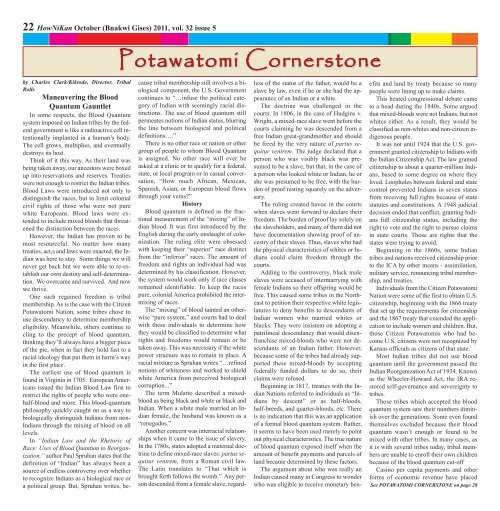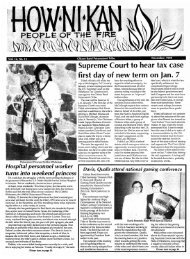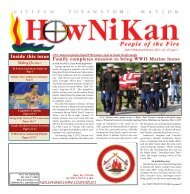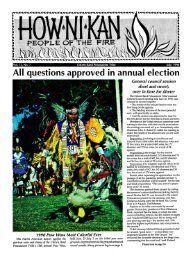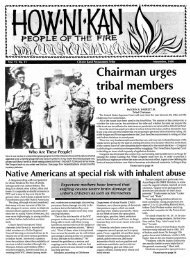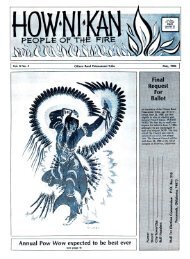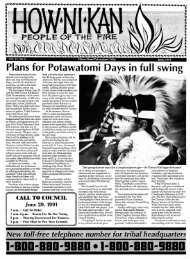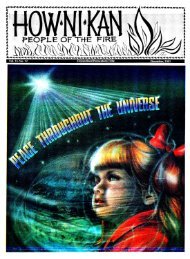October 2011 - Citizen Potawatomi Nation
October 2011 - Citizen Potawatomi Nation
October 2011 - Citizen Potawatomi Nation
Create successful ePaper yourself
Turn your PDF publications into a flip-book with our unique Google optimized e-Paper software.
22 HowNiKan <strong>October</strong> (Bnakwi Gises) <strong>2011</strong>, vol. 32 issue 5<br />
<strong>Potawatomi</strong> Cornerstone<br />
by Charles Clark/Kiktode, Director, Tribal<br />
Rolls<br />
Maneuvering the Blood<br />
Quantum Gauntlet<br />
In some respects, the Blood Quantum<br />
system imposed on Indian tribes by the federal<br />
government is like a radioactive cell intentionally<br />
implanted in a human’s body.<br />
The cell grows, multiplies, and eventually<br />
destroys its host.<br />
Think of it this way. As their land was<br />
being taken away, our ancestors were boxed<br />
up into reservations and reserves. Treaties<br />
were not enough to restrict the Indian tribes.<br />
Blood Laws were introduced not only to<br />
distinguish the races, but to limit colonial<br />
civil rights of those who were not pure<br />
white Europeans. Blood laws were extended<br />
to include mixed bloods that threatened<br />
the distinction between the races.<br />
However, the Indian has proven to be<br />
most resourceful. No matter how many<br />
treaties, act,s and laws were enacted, the Indian<br />
was here to stay. Some things we will<br />
never get back but we were able to re-establish<br />
our own destiny and self-determination.<br />
We overcame and survived. And now<br />
we thrive.<br />
One such regained freedom is tribal<br />
membership. As is the case with the <strong>Citizen</strong><br />
<strong>Potawatomi</strong> <strong>Nation</strong>, some tribes chose to<br />
use descendancy to determine membership<br />
eligibility. Meanwhile, others continue to<br />
cling to the precept of blood quantum,<br />
thinking they’ll always have a bigger piece<br />
of the pie, when in fact they hold fast to a<br />
racial ideology that put them in harm’s way<br />
in the first place.<br />
The earliest use of blood quantum is<br />
found in Virginia in 1705. European Americans<br />
issued the Indian Blood Law first to<br />
restrict the rights of people who were onehalf-blood<br />
and more. This blood-quantum<br />
philosophy quickly caught on as a way to<br />
biologically distinguish Indians from non-<br />
Indians through the mixing of blood on all<br />
levels.<br />
In “Indian Law and the Rhetoric of<br />
Race: Uses of Blood Quantum to Reorganization,”<br />
author Paul Spruhan states that the<br />
definition of “Indian” has always been a<br />
source of endless controversy over whether<br />
to recognize Indians as a biological race or<br />
a political group. But, Spruhan writes, because<br />
tribal membership still involves a biological<br />
component, the U.S. Government<br />
continues to “…infuse the political category<br />
of Indian with seemingly racial distinctions.<br />
The use of blood quantum still<br />
permeates notions of Indian status, blurring<br />
the line between biological and political<br />
definitions….”<br />
There is no other race or nation or other<br />
group of people to whom Blood Quantum<br />
is assigned. No other race will ever be<br />
asked at a clinic or to qualify for a federal,<br />
state, or local program or in casual conversation,<br />
“How much African, Mexican,<br />
Spanish, Asian, or European blood flows<br />
through your veins?”<br />
History<br />
Blood quantum is defined as the fractional<br />
measurement of the “mixing” of Indian<br />
blood. It was first introduced by the<br />
English during the early onslaught of colonization.<br />
The ruling elite were obsessed<br />
with keeping their “superior” race distinct<br />
from the “inferior” races. The amount of<br />
freedom and rights an individual had was<br />
determined by his classification. However,<br />
the system would work only if race classes<br />
remained identifiable. To keep the races<br />
pure, colonial America prohibited the intermixing<br />
of races.<br />
The “mixing” of blood tainted an otherwise<br />
“pure system,” and courts had to deal<br />
with these individuals to determine how<br />
they would be classified to determine what<br />
rights and freedoms would remain or be<br />
taken away. This was necessary if the white<br />
power structure was to remain in place. A<br />
racial mixture as Spruhan writes “…refined<br />
notions of whiteness and worked to shield<br />
white America from perceived biological<br />
corruption...”<br />
The term Mulatto described a mixedblood<br />
as being black and white or black and<br />
Indian. When a white male married an Indian<br />
female, the husband was known as a<br />
“renegados.”<br />
Another concern was interracial relationships<br />
when it came to the issue of slavery.<br />
In the 1780s, states adopted a maternal doctrine<br />
to define mixed-race slaves: partus sequitur<br />
ventrem, from a Roman civil law.<br />
The Latin translates to “That which is<br />
brought forth follows the womb.” Any person<br />
descended from a female slave, regardless<br />
of the status of the father, would be a<br />
slave by law, even if he or she had the appearance<br />
of an Indian or a white.<br />
The doctrine was challenged in the<br />
courts. In 1806, in the case of Hudgins v.<br />
Wright, a mixed-race slave went before the<br />
courts claiming he was descended from a<br />
free Indian great-grandmother and should<br />
be freed by the very nature of partus sequitur<br />
ventrem. The judge declared that a<br />
person who was visibly black was presumed<br />
to be a slave, but that, in the case of<br />
a person who looked white or Indian, he or<br />
she was presumed to be free, with the burden<br />
of proof resting squarely on the adversary.<br />
The ruling created havoc in the courts<br />
when slaves went forward to declare their<br />
freedom. The burden of proof lay solely on<br />
the slaveholders, and many of them did not<br />
have documentation showing proof of ancestry<br />
of their slaves. Thus, slaves who had<br />
the physical characteristics of whites or Indians<br />
could claim freedom through the<br />
courts.<br />
Adding to the controversy, black male<br />
slaves were accused of intermarrying with<br />
female Indians so their offspring would be<br />
free. This caused some tribes in the Northeast<br />
to petition their respective white legislatures<br />
to deny benefits to descendants of<br />
Indian women who married whites or<br />
blacks. They were insistent on adopting a<br />
patrilineal descendancy that would disenfranchise<br />
mixed-bloods who were not descendants<br />
of an Indian father. However,<br />
because some of the tribes had already supported<br />
these mixed-bloods by accepting<br />
federally funded dollars to do so, their<br />
claims were refused.<br />
Beginning in 1817, treaties with the Indian<br />
<strong>Nation</strong>s referred to individuals as “Indians<br />
by descent” or as half-bloods,<br />
half-breeds, and quarter-bloods, etc. There<br />
is no indication that this was an application<br />
of a formal blood quantum system. Rather,<br />
it seems to have been used merely to point<br />
out physical characteristics. The true nature<br />
of blood quantum exposed itself when the<br />
amount of benefit payments and parcels of<br />
land became determined by these factors.<br />
The argument about who was really an<br />
Indian caused many in Congress to wonder<br />
who was eligible to receive monetary benefits<br />
and land by treaty because so many<br />
people were lining up to make claims.<br />
This heated congressional debate came<br />
to a head during the 1840s. Some argued<br />
that mixed-bloods were not Indians, but not<br />
whites either. As a result, they would be<br />
classified as non-whites and non-citizen indigenous<br />
people.<br />
It was not until 1924 that the U.S. government<br />
granted citizenship to Indians with<br />
the Indian <strong>Citizen</strong>ship Act. The law granted<br />
citizenship to about a quarter-million Indians,<br />
based to some degree on where they<br />
lived. Loopholes between federal and state<br />
control prevented Indians in seven states<br />
from receiving full rights because of state<br />
statutes and constitutions. A 1948 judicial<br />
decision ended that conflict, granting Indians<br />
full citizenship status, including the<br />
right to vote and the right to pursue claims<br />
in state courts. Those are rights that the<br />
states were trying to avoid.<br />
Beginning in the 1860s, some Indian<br />
tribes and nations received citizenship prior<br />
to the ICA by other means - assimilation,<br />
military service, renouncing tribal membership,<br />
and treaties.<br />
Individuals from the <strong>Citizen</strong> <strong>Potawatomi</strong><br />
<strong>Nation</strong> were some of the first to obtain U.S.<br />
citizenship, beginning with the 1866 treaty<br />
that set up the requirements for citizenship<br />
and the 1867 treaty that extended the application<br />
to include women and children. But,<br />
those <strong>Citizen</strong> <strong>Potawatomi</strong>s who had become<br />
U.S. citizens were not recognized by<br />
Kansas officials as citizens of that state.<br />
Most Indian tribes did not use blood<br />
quantum until the government passed the<br />
Indian Reorganization Act of 1934. Known<br />
as the Wheeler-Howard Act, the IRA restored<br />
self-governance and sovereignty to<br />
tribes.<br />
Those tribes which accepted the blood<br />
quantum system saw their numbers diminish<br />
over the generations. Some even found<br />
themselves excluded because their blood<br />
quantum wasn’t enough or found to be<br />
mixed with other tribes. In many cases, as<br />
it is with several tribes today, tribal members<br />
are unable to enroll their own children<br />
because of the blood quantum cut-off<br />
Casino per capita payments and other<br />
forms of economic revenue have placed<br />
See POTAWATOMI CORNERSTONE on page 28


